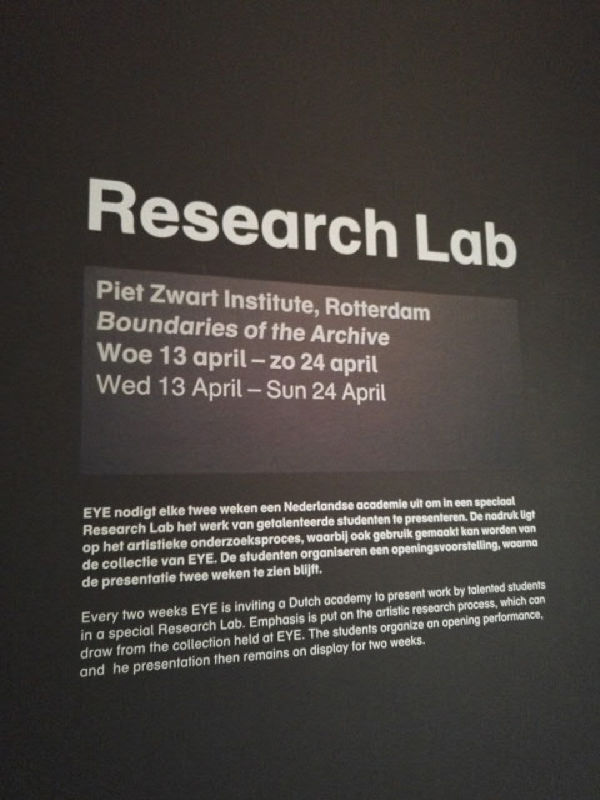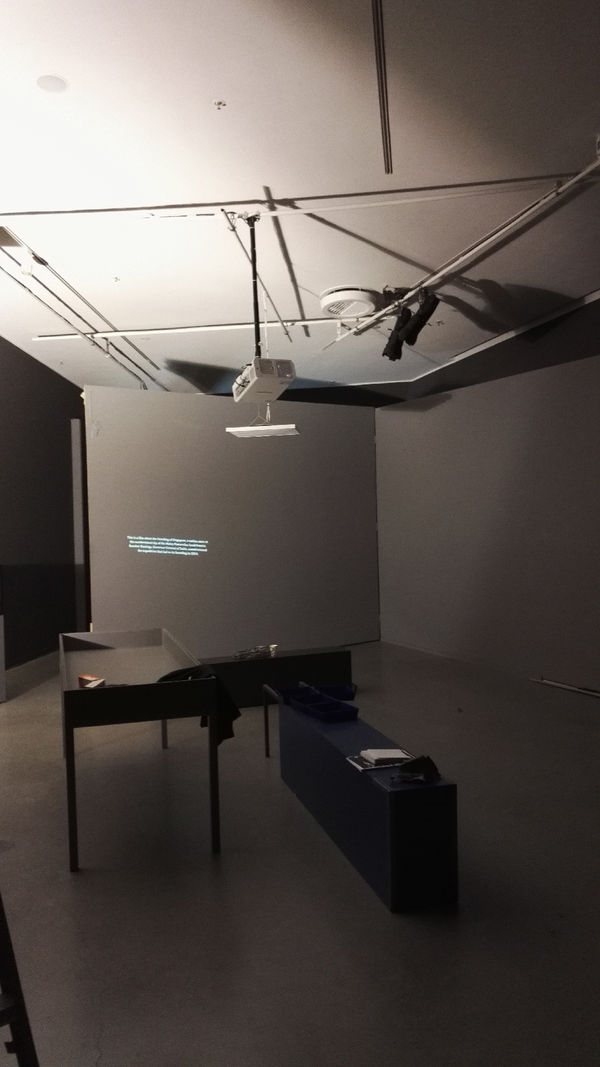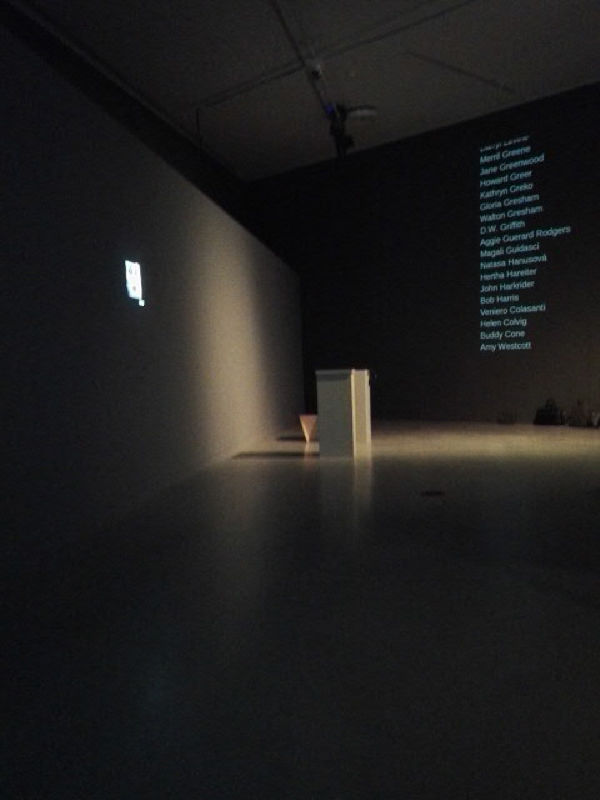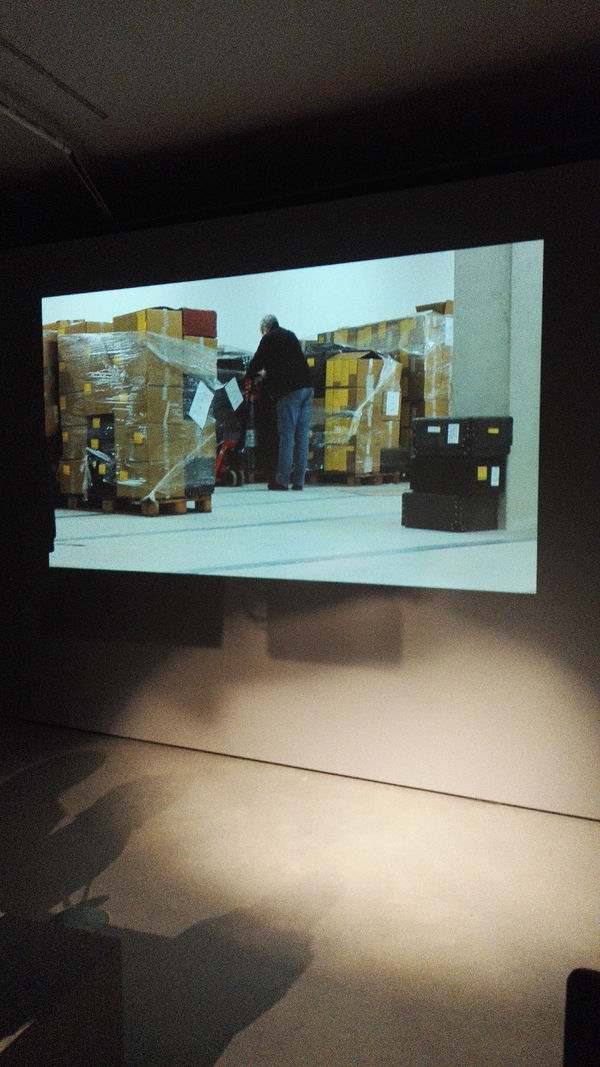EYE On Art: Difference between revisions
No edit summary |
(→IMAGES) |
||
| Line 133: | Line 133: | ||
[[File:Eyeonart00.jpg |600px ]] | [[File:Eyeonart00.jpg |600px ]] | ||
File:Eyeonart01.jpg |600px ]] | [[File:Eyeonart01.jpg |600px ]] | ||
File:Eyeonart02.jpg |600px ]] | [[File:Eyeonart02.jpg |600px ]] | ||
File:Eyeonart03.jpg |600px ]] | [[File:Eyeonart03.jpg |600px ]] | ||
Latest revision as of 12:34, 16 May 2016
This page is for the PZI ResearchLab EYE On Art 2016 programme.
Boundaries of the Archive. Main project text for use in media/prints/promotion
Boundaries of the Archive
The Piet Zwart Institute ResearchLab is focused on the boundaries of the archive. As media practitioners studying the structures and cultural impacts of our media technologies, we concentrate on the intricate and usually hidden aspects of EYE’s extensive archive.
The EYE Collection is internationally recognised for its outstanding historical breadth and quality, particularly in relation to Dutch cinema culture. Any limitations, frictions and little noticed quirks in the archival system serve as poetic inspiration.
The timing of this exhibition coincides with the moving of the EYE Collection to new premises. It provides a starting point to explore the materiality of both digital and analogue films, the poetics of cataloguing them, and the fragile semantics of a vast collection database.
Individial works/projects
Documentary film + 6 individual projects Overview equipment/media:
- Documentary film: video only; no sound (to be projected in short wall opposite door...)
- Thomas & Jules: video only; no sound
- Nataliya: video and sound
- Solange: sound only & sculptural instalation (film cans)
- Lucas & Yuzhen: video and sound
- Cihad: video and sound
- Ruben & Cristina: video and sound
Documentary film
The "documentary film" will be about 10 to 20 min long. No sound.
It mixes the EYE Collection locations and archivists at work, in a non-narrative edit.
1) Thomas and Jules
The aim of the project is to merge symbolically all the items of the archive through the realisation of a single End credit video. End credits list all the individuals involved in the production of a video. In this case, we would display the list of all individuals involved with the production of the content of the Eye's Archive regardless of the production they worked on. Those credits would be particularly long, (perhaps too long for the whole show) underlining the vertiginous amount of content gathered by the Eye's archive. Some names would be missing due to the very fact that they were not listed by the people who produced the data stored in the Archive's database. This doesn't really matter, as we consider that the relationship between a member of crew and the archive exists has the result of human labour (an archive's employee). Our approach is a way to insist more lightly on the physical difficulty for a human to apprehend the collection through a direct face-to-face.
Needed:
- a computer
- a video projector
- a bench
2) Nataliya
An audio-visual installation that explores metadata of the pieces from silent cinema collection, their visual language, and narrative specificities, to generate sound or, in other words, insonify the film. Few silent video pieces composed for 3 screens and insonifyed. The archiving process follows strict policy and sustains personal/human impact. My project is a metaphor for this process. I investigate the possibility of creating 'objective' model of sound generation and my personal impact on it as the author of maxims for the process. Insonification is based on motion vectors, extracted from the video and mapped to the process of sound generation. The way sound is synthesised is based on metadata and the rules I set up for it.
Facilities, needed for installation:
- Three screens
- Sound system (To discuss. Maybe we all will use headphones, maybe not)
- laptop to synchronize videos
3) Solange
For my personal project for the EYE, I’m going to give films an anthropomorphic voice to tell about their own individual experiences in the EYE archive. Each film tells a narrative, about their self’s, there past or present in the archive. Each with a different character and voice. I present an archive of narratives of the film archive. I present the past in the present. This will be an audio piece, but I was thinking of whispering voices. (You have to get close to her it)
What do I need:
- Sound system (I prefer not headphones, but that’s in consideration)
4) Lucas & Yuzhen
One concept I was developing involves the reading of the keyword list (Trefwoorden-thesaurus) - a selection of about 100 entries. The reading is done by several people, all non-Dutch speakers. (to highlight the language limitations in accesibility of this international archive).
The thesaurus system applied to the Eye Archive is a one to many system, in another word, there are many secondary items under each thesaurus that are correspnsive to the content of the Eye Archive. So I take each item into images.google.nl(because the staff from the eye also use google translate their thesaurus in English), and get the first image from the search results and make them into a sequence. Later on, it reminds me that when I did the "Dreamachine" research, Ruben showed me his mock up of this flicking effects with sequencing images. So I consider to make the video in this manner in this way to imply its limited communicability.
- I discussed with Lucus if it is possible to combine our works, since he has the audio parts and I have the vision part. Then maybe I should aplly the rhythm of images to his sound recordings.
- I tested with the genre-thesaurus items, but Lucus suggested that the keywords system is more subjective.
Equpment:
- Headphones
- one screen, no need to be big, could be 21.5" screen wrape with black surround.
5) Cihad
- Beamer
- Sound shower
6) Ruben & Cristina
Equipment:
- Monitor or projector
- Headphones
Equipment
What the EYE says:
They have:
- 3 beamers,
- 1 monitor, (though Anna mentioned they might have no monitors/tv screen at all)
- sound speakers,
- probably one headphones.
- We are going to project on the walls in dark grey, which enhances the colors of the videos, both colour and black and white works.
- We will use beamers with 4000 lumen and probably media players for mpg. More specifications will follow
- Contact on media player technical details, and overall equipment: Communication will be through Simon (Anna Dabrowska is not in charge any more on ResearchLab)
Exhibition design ideas
- Archive-porn film to be projected on the shorter wall, directly opposite the door.
Resources
Main Database
User name: bezoeker
Password: ceguestwelcome
Links
Eye Museum Collection Policy 2014-2017
Experimental film in the Netherlands
Korte Film Poule (short film pool)
From EYE presentation:
- Contact Tessa or Anna, ask Solange or Thomas
- The collection of Bits & Pieces (fragments from the early cinema in public domain suitable for remixes) can be accessed at any time but, except in a few cases, it is mostly in SD resolution.
- The collection of the Korte Film Poule (http://kortefilmpoule.eyefilm.nl) will be always available for curated screenings.
Old wiki page (initial ideas, etc)
Archived at: EYE on Art 2016 - Initial drafts





